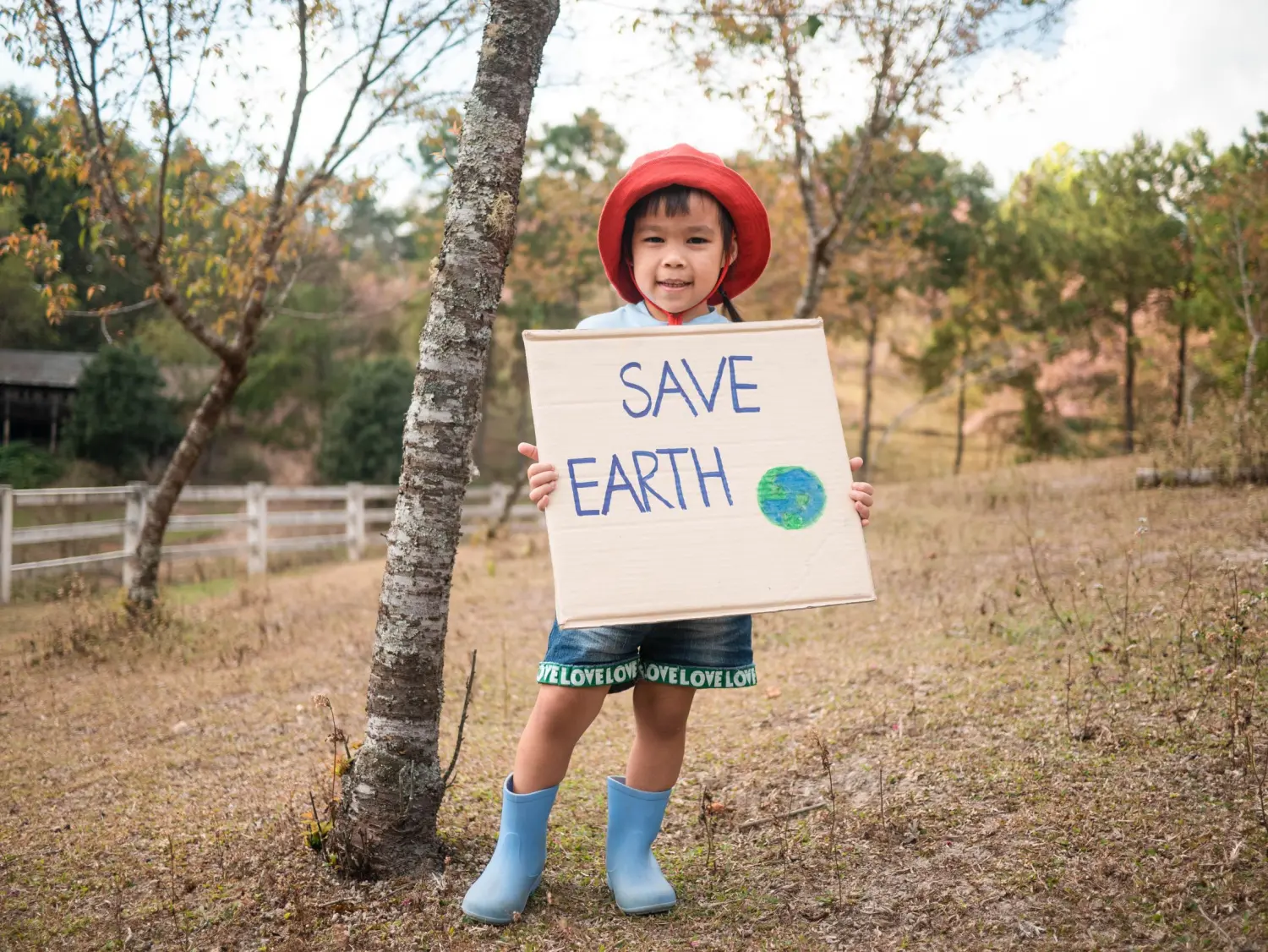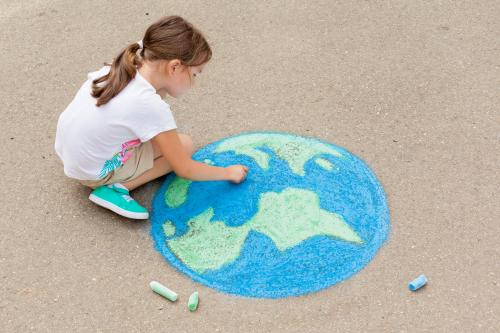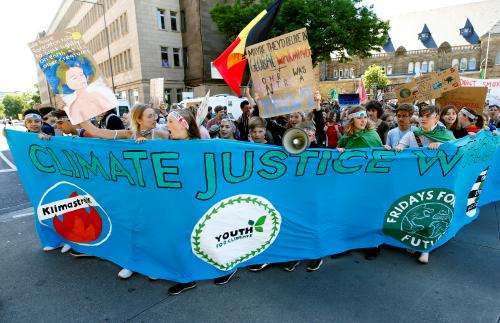As countries work to “build back better” from COVID-19, the education sector has a once-in-a-lifetime opportunity to build back differently. Unprecedented school disruptions have laid bare how existing inequalities within our education systems, including those structured along the intersections of gender and poverty, are exacerbated in times of crisis. Yet COVID-19 school disruptions are only a sample of what is to come as extreme weather events and zoonotic disease transfer become a more regular occurrence in the context of ecological collapse and climate breakdown.
To leverage our present moment of disruption for good, the education community must begin to see how building back “better” from COVID-19 is intertwined with both the road to achieving the Paris Agreement’s 1.5 degrees Celsius target—the upper limit to global temperature rise necessary to minimize the impact on people and ecosystems—and the road to achieving greater gender equality in and through education. The values that drive the domination and exploitation of the natural world, which fuel climate change and increase humanity’s vulnerability to zoonotic disease transfer, are the same values that drive the oppression, exploitation, and violence against vulnerable groups, especially girls and women.
A post-COVID-19 vision must aim to radically transform the underlying economic systems
of inequity and social structures of inequality that are at the root of our present suite of
socioecological crises.
A post-COVID-19 vision must aim to radically transform the underlying economic systems of inequity and social structures of inequality that are at the root of our present suite of socioecological crises. While the vision must be determined from the bottom up, this paper attempts to define how we might get there.
Specifically, this paper presents a heuristic intended to provide climate and education decisionmakers with: 1) a framework for conceptualizing the green skills needed to catalyze both technical and social transformation (see Figure 1) and 2) a tool for considering three approaches to quality education for climate action (see Figure 2). Depending on the context, certain approaches may be more feasible than others, although all three approaches should be pursued. Taken together, the framework presents a “new green learning agenda” in which each approach helps to solve a different aspect of the climate crisis in the spirit of the Paris Agreement—that is, through the lens of justice, equity, and fairness. As such, this framework offers proposals to ensure the needs and experiences of those often most vulnerable to the impacts of climate change and social inequity, especially girls and women, are prioritized.
Figure 1. A green skills framework
Figure 2. A green skills heuristic for climate action
The three approaches in the new green learning agenda
Approach 1 ensures technical education and training aimed at building specific capacities, or “skills for green jobs,” can achieve a just transition to a green economy through a gender-transformative approach. It expands our conceptualization of green skills beyond STEM skills to also include gender-empowerment skills like the ability to read, decode, and act upon one’s social environment. It argues that if girls and women are already excluded from the present brown economy, they will be at the fringes of a green economy without deliberate efforts to make green technical and vocational education and training initiatives more gender inclusive and gender transformative.
Approach 2 ensures that building “green life skills” translates into long-standing, pro-environmental behaviors by focusing on a critical, intersectional, and justice-oriented agenda in climate change education (CCE) or education for sustainable development (ESD). It conceptualizes green skills as the cognitive and socioemotional skills that can be “worn” like a pair of green glasses, helping individuals make greener decisions and engage in greener behaviors in a wide variety of contexts. It argues that if girls’ experiences are added to the “shade” of the green-tinted lenses, the resulting behaviors can be more gender empowering.
Approach 3, perhaps the most radical and important of the three, focuses on developing “skills for green transformation” by transforming mindsets and confronting the underlying structures of inequality and systems of oppression that sustain climate vulnerability. It positions green skills like disruptive thinking and political agency as core pieces of a larger framework of change that includes attention to the opportunity structures that enable or inhibit individual and collective climate action. It argues that through the development of girls’ (and boys’) feminist planetary conscious and the active disruption of gender inequality, education can seed the social transformation needed to achieve the 1.5 degrees Celsius target.
To adopt these approaches, a strong policy environment is imperative, as is the political will among state and nonstate actors to break with the status quo and bring resilience and adaptive capacity to an unsustainable system. Education has an important transformative role to play in seeding the mindset changes needed to replace unjust and unsustainable social and economic systems. But the education sector cannot do this alone. This paper suggests several policy entry points for decisionmakers and civil society to better leverage national and subnational opportunities for: capacity building and awareness, policy coherence and coordination, international collaboration, and financing local and grassroots efforts at scale.
Capacity building and awareness raising
Recognizing that green learning advocates are likely to engage decisionmakers and stakeholders with varying levels of climate knowledge, it would be prudent to:
- Build capacity and raise awareness on issues of gender, education, and climate justice.
- Raise awareness and understanding across the current and future teacher workforce of the anthropogenic drivers of climate change, the difference between low-impact and high-impact climate solutions, and the intersections between climate change and climate justice.
- Co-develop with educators a teacher training program and teacher leadership development program on gender-transformative education for climate action.
Policy coherence and coordination
Recognizing that there is a wide landscape of relevant international, national, and subnational policy, a coherent approach to education for climate action across these policy frameworks can enable downstream efforts at resource mobilization and implementation. To foster such coordination:
- Reference all three green learning agendas in Nationally Determined Contributions (national strategies to reduce greenhouse gas emissions), National Climate Change Learning Strategies, National Action for Climate Empowerment Strategies, and national green economy or low-emissions strategies.
- Align monitoring mechanisms for Sustainable Development Goals 4.7, 12.8, and 13.3 and Action for Climate Empowerment implementation to a more radical vision of education for climate action.
- Build a dashboard to monitor country coherence in national and/or subnational approaches to quality education for climate action.
International collaboration
Recognizing that a new green learning agenda should not be the responsibility of a few countries but of all countries, efforts must be made to:
- Lean in on the Paris framework for equity, justice, and fairness to call on developed countries to make good on their responsibility to support developing countries to fulfill their Nationally Determined Contribution targets.
- Leverage bilateral mechanisms, like feminist foreign policy, for more transformative multi-solving collaborations between countries.
- Build a transnational social movement and multisectoral coalitions of support for green, feminist transformation.
Financing local and grassroots efforts at scale
Recognizing that financing is key among the challenges to accelerating progress toward climate action, barriers to unlocking climate financing must be removed, including a lack of data for diagnostics and decisionmaking. Two important first steps are to:
- Develop a costing tool to determine the financing needed to implement the three approaches to a new green learning agenda.
- Push green financing mechanisms, as well as the OECD Development Assistance Committee, to develop a series of green learning agendas and/or action for climate empowerment markers to monitor climate financing toward quality, gender-transformative education for climate action.
At a practical level, this paper presents a heuristic for countries to determine the best entry points for orienting their education systems toward climate action and achieving a green, feminist transformation. It also provides the evidence and rationale for doing so, as well as concrete recommendations that will enable the pursuit of this agenda. At a conceptual level, this paper aims to help decisionmakers understand that they should not stop at education reform, but should identify pathways to transform education as we currently know it. We should not settle with doing education as we know it better, but rather push ourselves to see how education can be done differently.










